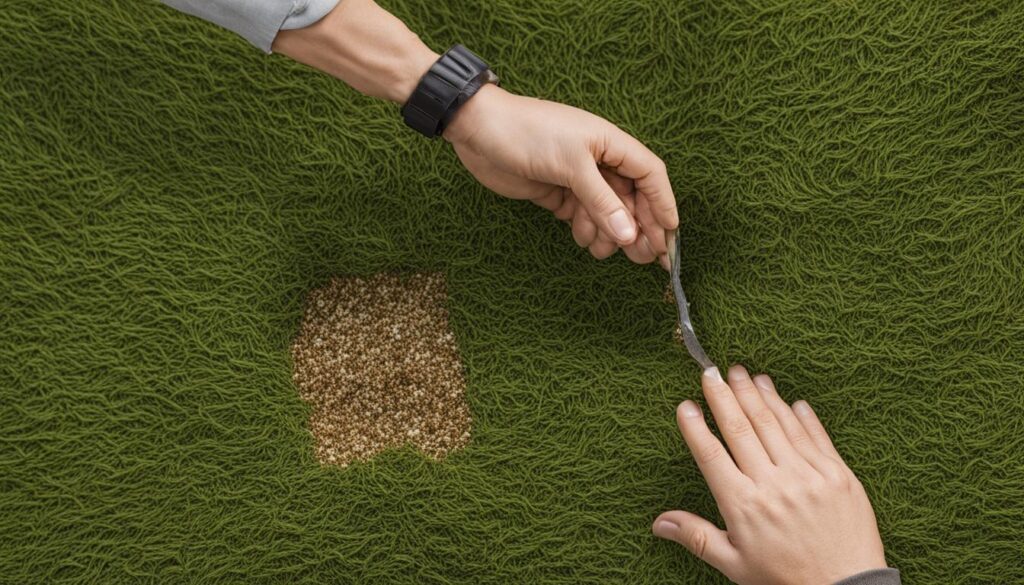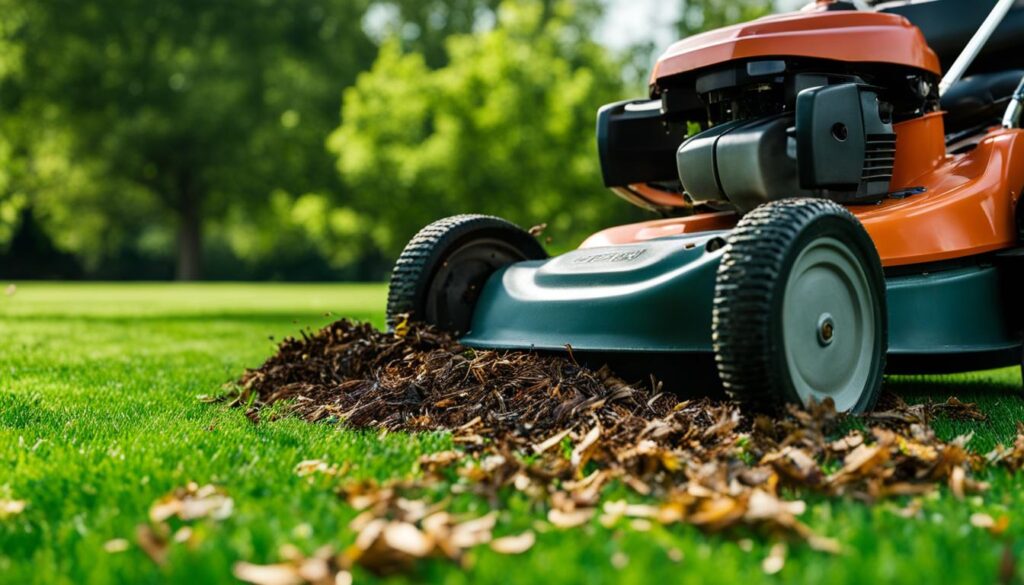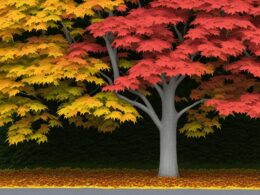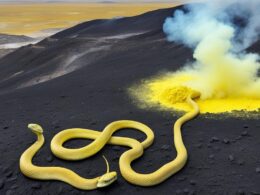Welcome to our comprehensive guide on treating dollar spot, a common lawn disease that can result in unsightly patches of dead turfgrass. Dollar spot is caused by the pathogen Clarireedia jacksonii and can quickly spread if left untreated. In this article, we will discuss how to identify dollar spot symptoms, the importance of proper lawn maintenance, and effective prevention strategies.
Dollar spot presents as silver-dollar-sized spots of dead grass with hourglass-shaped lesions. These lesions have bleached centers and reddish-brown to purplish borders. The affected areas may also display a distinctive mycelium coating, which appears like a cobweb and is most visible in the morning when dew is present.
Ignoring dollar spot can lead to the spread of the disease and the formation of larger areas of dead grass. To prevent this, it is essential to incorporate a combination of fungicide application and proper lawn maintenance into your routine. By following the expert advice provided in this article, you can banish dollar spot from your lawn and restore its lush green beauty.
Stay tuned for the upcoming sections where we will delve deeper into identifying dollar spot symptoms, preventing the disease through proper lawn maintenance routines, and exploring various techniques such as aeration, compost application, grub control, dethatching, fertilization, irrigation, mowing, mulching, and more. Let’s get started on your journey to a healthier, disease-free lawn!
Identifying Dollar Spot Symptoms
One of the key steps in effectively managing dollar spot in your lawn is to correctly identify its symptoms. By recognizing the signs of dollar spot, you can take appropriate action to prevent further damage to your turfgrass.
Dollar spot is characterized by the presence of silver-dollar-sized spots of dead turfgrass scattered throughout the lawn. These spots are easily noticeable and can vary in size. Upon closer inspection, you will observe that the affected grass blades exhibit hourglass-shaped lesions with bleached centers and reddish-brown to purplish borders.
To further confirm the presence of dollar spot, examine the affected areas in the morning when dew is present. You may notice a delicate cobweb-like coating called mycelium, which appears silver in color. This mycelium coating is a clear indicator of dollar spot infection and is most visible during the early hours of the day.
Preventing Dollar Spot with Proper Lawn Maintenance
Maintaining a proper lawn care routine is key to preventing dollar spot and keeping your lawn healthy and vibrant. By following a few essential steps in your lawn maintenance routine, you can effectively minimize the risk of this troublesome turfgrass disease.
Mowing: Regularly mowing your lawn at the recommended height helps to promote healthy grass growth and prevent the development of dollar spot. Be sure not to cut the grass too short, as this can weaken the turf and make it more susceptible to disease.
Watering: Adequate and proper watering is crucial in preventing dollar spot. Water deeply and infrequently to encourage the growth of deep roots, and avoid watering in the evening to minimize the risk of prolonged leaf wetness that can promote disease development.
Fertilizing: Applying a balanced fertilizer according to your soil’s needs helps to maintain optimal turf health and reduce the risk of dollar spot. Pay attention to the nitrogen content in your fertilizer, as dollar spot thrives in low-nitrogen environments. Consult a professional or perform a soil test to determine the right fertilizer application for your lawn.
Aerating: Regularly aerating your lawn helps to alleviate soil compaction, improve air circulation, and promote better water and nutrient absorption. Core aeration or spike aeration can be effective methods for preventing dollar spot.
Applying Compost: Adding compost to your lawn helps to enrich the soil with essential nutrients and increase the population of beneficial microbes. This can enhance the overall health of your turfgrass and make it more resistant to disease, including dollar spot.
Controlling Grubs: Grubs can weaken your turfgrass and make it more susceptible to diseases like dollar spot. Implement effective grub control measures, such as using curative or preventative insecticides or introducing nematodes, to keep grubs in check.
Dethatching: Thatch buildup can create a favorable environment for dollar spot disease. Regular dethatching, which involves removing accumulated dead organic material from the surface of your lawn, can help prevent the development and spread of dollar spot.
Using Fungicides: While fungicides can be effective in treating dollar spot, they should be used as part of an integrated approach that includes proper lawn maintenance. Applying fungicides alone may provide only temporary relief, as dollar spot can quickly develop resistance. It is advisable to consult with a professional to determine the most appropriate fungicide and application timing for your lawn.
By incorporating these preventative measures into your lawn care routine, you can significantly reduce the risk of dollar spot and keep your lawn looking lush and healthy.
Aerating and Applying Compost for Dollar Spot Prevention
Aerating your soil is a crucial step in preventing dollar spot, a common lawn disease. Soil compaction inhibits the flow of air, water, and nutrients to the grassroots, creating an environment favorable for the development of dollar spot. By aerating your lawn, you can alleviate compaction and promote a healthier turf.
There are two popular methods for soil aeration: core aeration and spike aeration. Core aeration involves removing small plugs or cores of grass and soil from the lawn, while spike aeration involves creating holes in the ground using a specialized tool. Both methods effectively break up compacted soil, allowing air, water, and nutrients to penetrate deeper into the roots.
In addition to aeration, applying compost to your lawn can further enhance its resistance to dollar spot. Compost contains organic matter that enriches the soil by improving its structure and increasing the population of beneficial microbes. These microbes play a crucial role in breaking down organic matter and releasing essential nutrients for the grassroots. Compost can be applied by spreading a thin layer across the lawn or brewing it into a compost tea and spraying it onto the turf.
To visually illustrate the process of core aeration and compost application, take a look at the image below:
Incorporating regular soil aeration and compost application into your lawn maintenance routine can significantly reduce the severity of dollar spot and promote overall lawn health.
Controlling Grubs and Dethatching for Dollar Spot Prevention
Controlling grubs is crucial for preventing dollar spot, a common lawn disease. Grubs are the larvae of scarab beetles and they can weaken your turf by feeding on its root system. To effectively control grubs, you have a few options:
- Curative insecticides: These products are designed to kill grubs that are already present in your lawn. They work by targeting the grubs directly and stopping their growth and development. When using curative insecticides, it’s important to follow the manufacturer’s instructions carefully to ensure effective treatment.
- Preventative insecticides: These products are applied to your lawn before grubs become a problem. They create a barrier in the soil that kills grubs as they hatch and attempt to feed on your grass roots. Preventative insecticides are a proactive approach and can help you avoid grub damage altogether.
- Nematodes: Another natural option for grub control is using nematodes, which are microscopic worms that feed on grubs. These beneficial organisms can be applied to your lawn and they will seek out and destroy grubs in the soil. Nematodes are safe for the environment and do not pose a risk to humans, pets, or other beneficial insects.
In addition to controlling grubs, dethatching your lawn is an important step in preventing dollar spot. Dethatching involves removing the layer of dead organic matter that accumulates between the soil and the grass. This layer, known as thatch, can prevent your grass from accessing the nutrients, water, and oxygen it needs to thrive. By dethatching your lawn, you create an optimal environment for healthy grass growth and minimize the risk of dollar spot and other lawn diseases.
Fertilizing and Irrigating for Dollar Spot Prevention
Fertilizing and irrigating your lawn properly is crucial for preventing dollar spot. By following the right practices, you can ensure your lawn has the necessary nutrients and moisture to stay healthy and disease-free.
One important step in fertilizing your lawn is to perform a soil test. This will help identify any nutrient deficiencies and guide you in the fertilization process. Dollar spot thrives in lawns with low nitrogen levels, so it’s important to use an adequate amount of nitrogen fertilizer to promote healthy grass growth.
Proper irrigation is also key to preventing dollar spot. Watering deeply and less frequently encourages a robust root system, making your lawn less susceptible to diseases like dollar spot. On the other hand, watering for short periods too often can result in a shallow root system, leaving your lawn vulnerable to diseases.
It’s best to water your lawn in the early morning when the sun is not too strong, as this allows the grass to dry before nightfall, reducing the risk of disease. Investing in a sprinkler system can also help ensure your lawn receives consistent and adequate moisture.
Mowing and Mulching for Dollar Spot Prevention
Proper mowing practices are essential for preventing dollar spot from wreaking havoc on your lawn. By following a regular and correct mowing routine, you can avoid overgrown grass, which is not only unsightly but also highly attractive to disease and pests. Maintaining the right grass height is crucial to keep your lawn healthy and disease-free.
Lawn Mowing Tips:
- Mow your lawn regularly to prevent the grass from becoming too long.
- Ensure your mower blades are sharp to make clean cuts and reduce stress on the grass.
- Avoid cutting more than one-third of the grass blade length at a time.
- Adjust the cutting height according to the type of grass you have and the season.
- Alternate the mowing direction to prevent compaction and encourage upright growth.
Mulching with grass clippings is another effective measure for preventing dollar spot. When you leave grass clippings on the lawn after mowing, they act as a natural mulch, helping to retain moisture, regulate soil temperature, and add nutrients back into the soil. This mulching process not only enhances the health of your lawn but also discourages the growth of dollar spot disease.
Mulching Tips:
- Ensure that the grass clippings you use for mulching are free from disease and contamination.
- Spread a thin layer of grass clippings evenly across the entire lawn.
- Avoid clumping the clippings together, as this can create an ideal environment for disease development.
- Consider using a mulching mower to finely chop the clippings for better dispersion.
Remember that effective prevention against dollar spot involves a holistic approach. Alongside proper mowing and mulching techniques, it’s crucial to practice overseeding, remove weeds and debris, and maintain overall lawn health. Following these steps diligently will significantly reduce the risk of dollar spot and keep your lawn looking lush and vibrant.
Is Dollar Spot a Result of Improper Lawn Maintenance, Including Mowing?
Dollar spot in lawns can be exacerbated by improper lawn maintenance, including mowing. When grass is cut too short or too frequently, it becomes stressed and more susceptible to the disease. To avoid high lawn mowing costs today, it’s important to maintain proper mowing practices to prevent dollar spot from taking hold.
Conclusion
Preventing and treating dollar spot, a common lawn disease, requires a proactive approach to proper lawn maintenance. By following a routine lawn care regimen which includes mowing, watering, fertilizing, aerating, and applying compost, you can significantly reduce the risk of dollar spot development. Additionally, controlling grubs, dethatching the lawn, implementing proper irrigation practices, and mulching with grass clippings can further enhance your efforts to prevent this frustrating disease.
Regular mowing not only keeps your turf healthy, but it also helps prevent overgrown grass, which is more susceptible to diseases like dollar spot. Proper irrigation techniques, such as deep watering and using a sprinkler system, ensure the roots of your lawn remain strong and healthy.
By incorporating these preventive measures into your lawn maintenance routine, you can enjoy a lush, vibrant lawn that is resilient against dollar spot and other lawn diseases. Remember to remove weeds and debris, overseed as needed, and maintain overall lawn health to further protect your lawn from dollar spot and maintain its natural beauty.











